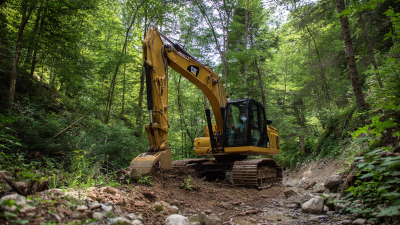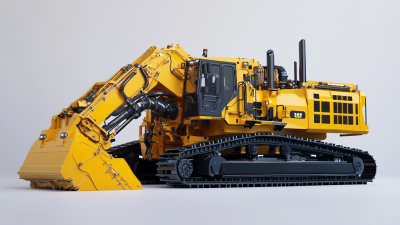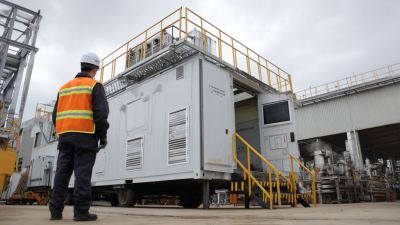Maximize Your Project Efficiency: A Deep Dive into Trencher Rental Benefits and Best Practices
In today’s fast-paced construction landscape, optimizing project efficiency is more critical than ever. As outlined in a recent report from the Equipment Leasing and Rental Association (ELRA), the rental market for construction equipment, including trenchers, is projected to achieve a compound annual growth rate of 4.2% through 2025. This trend highlights the growing reliance on trencher rental services, which not only mitigate upfront capital costs but also offer flexibility and access to the latest technology. By leveraging trencher rental, contractors can significantly enhance their operational efficiency, as these specialized machines enable efficient digging and installation tasks in various landscaping and utility projects.

Additionally, incorporating best practices in trencher rental can lead to reduced downtime, improved project timelines, and better resource management, ultimately driving higher profitability. Embracing trencher rental can be a game-changer for construction teams striving to meet deadlines and budget constraints while maintaining quality workmanship.
Benefits of Trencher Rental: Cost-Effectiveness for Project Budget Management
Renting a trencher can significantly enhance your project's budget management, allowing for cost-effectiveness without sacrificing quality. By choosing to rent, you eliminate the high upfront costs associated with purchasing equipment. This frees up valuable financial resources that can be allocated to other critical areas of your project, such as labor or materials. Additionally, rental agreements often include maintenance and support, reducing unforeseen expenses and ensuring that you have access to well-maintained equipment.
**Tip:** When renting a trencher, always assess your project needs carefully. Evaluate the scope and duration of your project to choose the right type and size of trencher. This not only helps in optimizing costs but also ensures that the equipment you choose is capable of handling the specific demands of your task.
Furthermore, with trencher rentals, you benefit from the latest technology without being tied down by ownership. Rental companies frequently update their fleet, giving you access to state-of-the-art models that improve efficiency and productivity on site. This can translate into faster completion times and reduced labor costs, making your project more profitable.
**Tip:** Build a relationship with your rental provider. Familiarity can lead to better rates, as well as tailored advice on which equipment works best for your specific project needs. This partnership can further enhance the cost-effectiveness of your trencher rental strategy.
Maximize Your Project Efficiency: Trencher Rental Benefits
Enhancing Workflow Efficiency: How Trenchers Reduce Time on Excavation Tasks
When it comes to excavation tasks, trenchers stand out as powerful tools that significantly enhance workflow efficiency. Their specialized design allows for precise digging, meaning that projects can progress swiftly without the extensive time typically associated with traditional excavation methods. By minimizing manual labor and automating the digging process, trenchers not only save time but also reduce the risk of injury, making them a vital asset for any construction site.
**Tips:** When renting a trencher, always assess the specific requirements of your project. Choose a model that suits your soil type and trench depth. Additionally, ensure that operators are trained to handle the equipment properly to maximize both safety and efficiency.
Furthermore, trenchers can effectively navigate tight spaces that larger excavation equipment cannot. This advantage allows teams to work more flexibly, adapting to project needs without significant downtime. By utilizing trenchers, contractors can maintain momentum, leading to quicker completion of tasks.
**Tips:** Regular maintenance checks before each rental day can prevent unexpected breakdowns. Create a checklist for equipment condition and report any issues immediately to avoid delays in your project schedule.

Industry Data Insights: Trencher Utilization Rates and Their Impact on Productivity
The growing emphasis on clean energy and stringent emission regulations are catalyzing a significant increase in subsea cable burial projects. As governments worldwide push for more sustainable solutions, the trenching industry is witnessing untapped growth opportunities. According to recent industry reports, trencher utilization rates are rising, with some regions experiencing up to a 15% increase annually in demand as projects expand. This trend not only enhances productivity but also boosts the efficiency of trenching operations, making it crucial for companies to adopt modern trenching solutions.

In addition to these trends, the adoption of advanced analytics is becoming essential for companies operating in sectors that rely on trenchers. Industries such as oil and gas, which have historically underutilized their offshore platforms running at only 77% of their maximum production capacity, are now leveraging data analytics to optimize output. With the right tools and insights, companies can move towards improving their trenching methods and overall project efficiency, thus aligning with industry data that highlights the tangible benefits of optimized trencher utilization in enhancing productivity and reducing operational costs.
Best Practices for Trencher Rental: Maximizing Equipment Lifetime and Performance
When considering trencher rentals, maximizing equipment lifetime and performance is essential for project efficiency. Proper maintenance and operation practices can significantly extend the working life of trenchers. According to a report by EquipmentWatch, regular servicing can reduce machinery downtime by up to 30%, which directly impacts project timelines and costs.
Tips: Always refer to the manufacturer's guidelines for maintenance schedules and operational procedures. Performing daily checks, such as monitoring fluid levels and inspecting tracks and blades for wear, can prevent costly repairs and ensure optimal performance throughout the rental period.
Additionally, selecting the right trencher size and type for your specific project needs is crucial. A study conducted by the American Rental Association indicates that choosing appropriately sized equipment can enhance productivity by 25%. Overloading a trencher not only reduces efficiency but also leads to increased wear and potential mechanical failures.
Tips: Before renting, assess the project requirements thoroughly—consider the soil type, trench depth, and width. Collaborate with your rental provider to ensure you’re matched with the right equipment tailored to your job specifications for peak performance.
Safety Protocols in Trencher Operations: Minimizing Risk and Ensuring Compliance
In trenching operations, safety protocols are paramount to minimize risks and ensure compliance with industry standards. According to the Occupational Safety and Health Administration (OSHA), trench collapses can pose significant hazards, leading to fatalities in approximately one-third of all excavation-related deaths. Implementing comprehensive safety measures, including the use of protective systems such as trench boxes and shoring, can greatly reduce these risks. Proper training for operators and workers is also essential; the National Utility Contractors Association (NUCA) emphasizes that a well-trained team is crucial for responsive and safe operations on-site.
Regular inspections and maintenance of trenching equipment, such as trenchers, further enhance safety. The American Society of Civil Engineers (ASCE) recommends that contractors implement a structured checklist to ensure all equipment meets safety standards before use. Additionally, clear communication among team members regarding potential hazards and emergency procedures is vital. Studies show that projects that prioritize safety practices not only comply with regulations but also experience fewer accidents, resulting in improved overall efficiency and productivity. By creating a robust safety culture surrounding trenching operations, companies can protect their workers while maximising project efficiency.
Related Posts
-

How to Choose the Right Trencher Rental for Your Construction Project Needs
-

How to Choose the Right Trencher Rental for Your Project Needs
-

Unlocking Efficiency with 2023 Jackhammer Rental Essential Specs and Proven Performance Metrics
-

Unlocking Global Opportunities: 5 Key Certifications for Successful Trencher Rental Exports
-

Maximize Your Project Efficiency with Reliable Industrial Equipment Rental Solutions
-

Leading Global Confidence in Industrial Equipment Rental from Top Chinese Factories